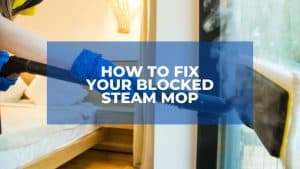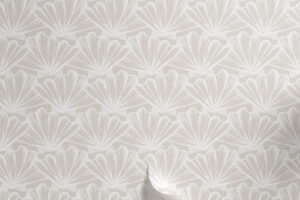Steam cleaners are the best at making hard floors, mattresses, carpets, and other surfaces clean and hygienic without harmful chemicals. But with prolonged use, poor maintenance, or incorrect use, these machines can get blocked and stop functioning correctly.
Fortunately, there’s no cause of alarm as we help you fix blockage problems with your steam mop in minutes. So, whether it’s the nozzle or any other part that has the problem, we’re here with the solution.

Quick Navigation
How Do I Fix A Blocked Steam Mop?
We’ve described a sure troubleshooting hack for your clogged steam mop here. It involves using baking soda/vinegar, descaling the nozzle, and other things. Read on to discover more.
What Causes Blockage in Your Steam Mop?
Many things can cause blockage in your steam mop with the main victims being mineral and chemical product deposits. But most of the time, mineral deposits due to hard water in your house can cause blockage when the limescale builds up inside your machine over time.
But this doesn’t mean you’re safe if you have fresh water. Calcium, which can be present in both fresh and hard water, can also cause deposits.
That’s why we encourage you to use the machine only with the type of water recommended by your manufacturer. Most manufacturers recommend using distilled water.
One more thing, always remember to empty your machine’s tank before storage as water in the tank is yet another victim. Fabric softeners and dryer sheets also add to the list of sources of deposits that can build up on your machine’s parts; hence, causing a blockage.
A Step-by-step Guide On How To Quickly Fix A Blocked Steam Mop
The following steps are useful for troubleshooting the problems with a blocked steam mop.
Here’s a list of what you’ll need:
- Descaling pin
- Vinegar
- A Clean Piece of Cloth
- Distilled Water
- Cotton Swabs
a) Unplug The Machine And Let it Cool Down
This is the starting point because you need to fix the machine while it’s cool. Therefore, unplug and give it some good time to cool, maybe as you gather the things listed above.
b) Add Vinegar To The Empty Water Tank
When it’s cool, you can now empty the water reservoir and add equal parts of distilled water and vinegar to the tank. This mixture helps break down debris as well as loosen minerals that cause blockage.
We recommend that you leave the mixture in the reservoir for 12 hours (mostly overnight) before proceeding with the next step.
It’s also safe to use baking soda and distilled water instead of vinegar. In fact, this mixture gives off little or no odors. But we stick to vinegar since its results are often better than baking soda.
Please avoid tap water as much as possible because it may contain an element of hard water.
c) Steam With The Vinegar
After the period specified above, plug the machine, let the mixture boil, and pull the trigger to start steaming. The vinegar mixture will remove mineral deposits and vinegar because it’s a top-notch cleaner.
However, we strongly advise you against using the solution to steam your floor because it contains all the debris from the inside of your machine.
d) Add Distilled Water And Steam Again
After the water tank is empty from your previous steaming, add distilled water (only), let the machine boil, and start steaming again. This time, you aim to rinse the machine to remove any remaining debris.
Again, don’t steam this against your floors or any surface as the solution from your machine isn’t yet clean for that purpose. But once it’s done, the machine should be fine now.
e) Locate And Descale The Spray Tip
You’re now done with the interior parts of your steam mop. It’s time to unclog its tip. Tondo this, you need a cotton swab and descaling pin (or a paper clip). Start by unplugging the machine and letting it cool.
- Find the spray top of your steam mop, usually at its base. Please check your user manual to hide you better on how to access the spray tip.
- Confirm if the spray nozzle has any debris and or buildups.
- Insert one end of your descaling pin or paper clip into the spray nozzle and move it in circles to release any deposits at the edges of the nozzle, if any.
- Use the cotton swab to wipe away the debris loosened above.
f) Wipe The Mop Head
Lastly, you can now wipe the machine’s mop head using a clean, vinegar-damp piece of cloth. After this last step, your steaming machine should be working properly. Meanwhile, if it doesn’t, please check the following.
What Else Could Be the Problem?
1. The Water Isn’t Heated Properly
Your steam mop machine will only release a sufficient amount of steam when the water in its tank is heated to the right temperatures. Usually, heating the water to 212°F is recommended for killing most types of microorganisms and eliminating germs and pests.
2. There’s A Leakage
It goes without saying that leakages reduce pressure in your steam mop, which depends on it to work properly. Please check if water or steam is leaking from the machine and find ways to fix the problem.
3. No Water in The Tank
Steam mops work perfectly when the amount of recommended water is present in the tank. And, it’s often easy to overlook adding a sufficient amount of water, especially when you’re in a hurry to clean your dirty surfaces.
Running your machine without the recommended volume of water is dangerous to its life and the user, too.
Preventing Future Steam Mop Failures And Blockages
1. Use Only Distilled Water
Most manufacturers recommend that you use their machines with distilled water only. Otherwise, hard and tap waters contain calcium and other minerals that cause clogging inside the machine’s parts and the nozzle. Too much of this can damage or void the warranty of your machine.
2. Plan Regular Cleanings
Debris and other unwanted elements are sure to find their way into your steam mop. But you don’t have to wait until a blockage occurs to clean the machine. You can make it a regular exercise to protect against damages that may be caused by too much blockage.
Alternatively, you can add a few drops of vinegar to the distilled water in your tank occasionally to get rid of debris and clogs. Cleaning the machine every week is highly recommended.


